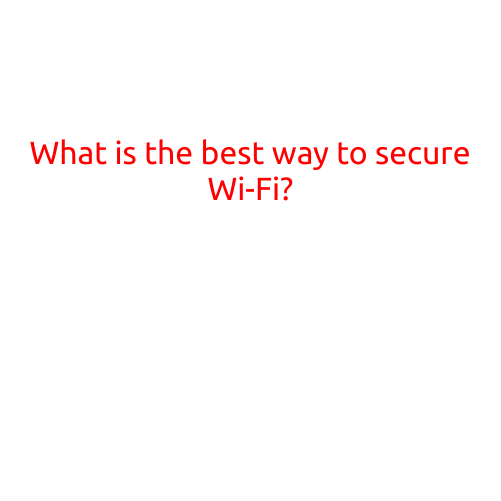
What is the Best Way to Secure Wi-Fi?
As the number of wireless devices and networks continues to grow, securing your Wi-Fi network has become an essential aspect of protecting your online presence. With the increasing threat of cyber attacks and data breaches, it’s crucial to ensure that your Wi-Fi network is secure and protected from unauthorized access.
In this article, we’ll dive into the best ways to secure your Wi-Fi network, keeping your personal data and devices safe from prying eyes.
Why Securing Your Wi-Fi is Important
Before we delve into the best practices for securing your Wi-Fi, let’s understand why it’s so important.
Unsecured Wi-Fi networks are a haven for hackers, who can:
- Steal sensitive information like passwords, credit card numbers, and personal data
- Install malware and viruses on your devices
- Use your internet connection to conduct illegal activities
- Gain access to your networks and other connected devices
To avoid these risks, it’s essential to secure your Wi-Fi network with robust security measures.
1. Change Your Default Password
When setting up your Wi-Fi router, it’s crucial to change the default password from the manufacturer’s settings to a strong, unique password. This is the first line of defense against unauthorized access.
2. Use WPA2 Encryption
WPA2 (Wi-Fi Protected Access 2) is the latest and most secure encryption protocol for wireless networks. Make sure your router is configured to use WPA2 encryption, as it’s more secure than older protocols like WEP or WPA.
3. Set Up a Guest Network
A guest network is a separate network for visitors, preventing them from accessing your main network and sensitive information. This adds an extra layer of security and segmentation.
4. Limit Access to Authorized Devices
Only allow devices that need access to your network to connect. By limiting access, you reduce the risk of unauthorized access and data breaches.
5. Regularly Update Your Router’s Firmware
Keep your router’s firmware up-to-date to ensure you have the latest security patches and features. Outdated firmware can leave your network vulnerable to attacks.
6. Use a VPN (Virtual Private Network)
A VPN creates a secure, encrypted connection between your device and the internet. This adds an extra layer of protection when using public Wi-Fi networks or when you’re away from your main network.
7. Monitor Your Network Activity
Use a network monitoring tool to keep an eye on your network’s activity. This helps you detect unusual activity and potential security breaches.
8. Implement Quality of Service (QoS) Settings
QoS settings help prioritize critical network traffic, ensuring that sensitive data receives priority and reducing the risk of data breaches.
9. Keep Your Devices’ Wi-Fi Settings Secure
Regularly check and update your devices’ Wi-Fi settings to ensure they’re configured correctly and securely.
10. Consider Implementing Additional Security Measures
Consider implementing additional security measures like:
- Network firewalls
- Intrusion detection systems
- Web application firewalls
In conclusion, securing your Wi-Fi network is a crucial step in protecting your online presence. By implementing these best practices, you’ll significantly reduce the risk of unauthorized access and data breaches. Remember to stay vigilant and regularly update your security measures to ensure your network remains secure.
Stay safe online!





